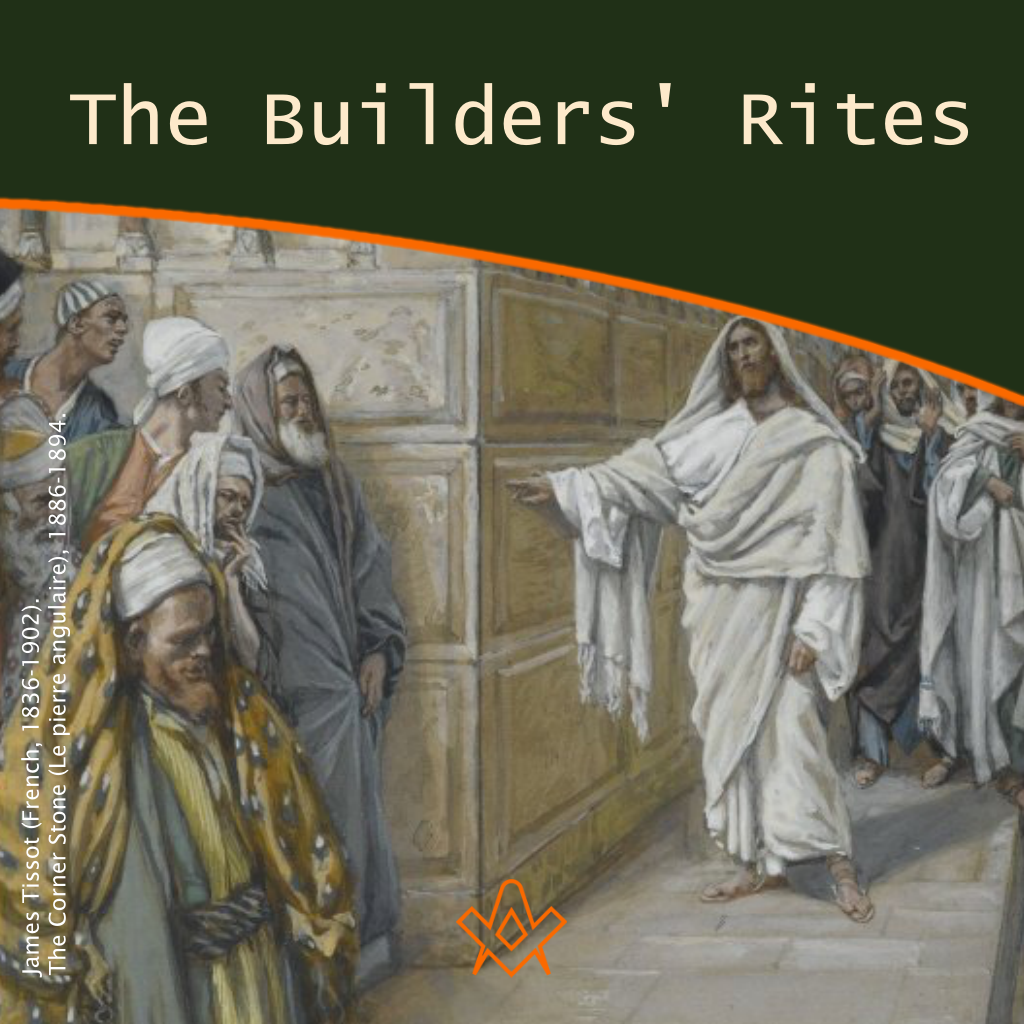The use of distinct ceremonies when constructing buildings of importance have been in existence since time immemorial.
Known as ‘Builders’ Rites’, they are performed at the point of laying the foundations and the setting of the cornerstone in any significant construction.
Traditions throughout the world have employed them in a variety of ways, some of which were less salubrious than others but were indicative of the religious or cultural aspects that have long been associated with the practice.
The cornerstone (also ‘foundation’ or ‘setting’ stone) is the first stone to be set in the construction of the foundations of a building; every other stone is set in reference to this.
We have examples across the world of rites or ceremonies performed in ancient times, such as in Egypt, where ‘foundation deposits’ have been discovered at various prominent temples, one notable discovery was from Deir el-Bahari, the mortuary temple of the female pharaoh Hatshepsut on the West Bank of Thebes [Luxor].
Foundation deposits are the archaeological remains of ritual burial objects which had been strategically placed at various points under temples, tombs, or other significant buildings.
In Egypt, these took the form of mudbrick lined pits filled with ritual objects such as amulets, food or miniature working tools of the stonemasons working on the building.
These objects were symbols of protection, to preserve the temple from ruin.
Part of this vital foundation ceremony was a ritual known as ‘the stretching of the cord’, whereby the buildings perimeter would be laid out by stretching a cord between stakes driven into the ground at measured intervals.
The mudbrick pits excavated at Deir el-Bahari included:
…alabaster ointment jars, pottery vessels containing food, folded pieces of linen cloth, reed mats, model tools, ritual implements, and meat offering from the cattle slaughtered during the foundation ceremony.
Below is a reconstruction of one of the eleven foundation deposits excavated at Hatshepsut’s temple, of which eight were discovered by the Metropolitan Museum’s Egyptian Expedition.
It represents a selection of objects found in the deposits in the lower courtyard of the temple.
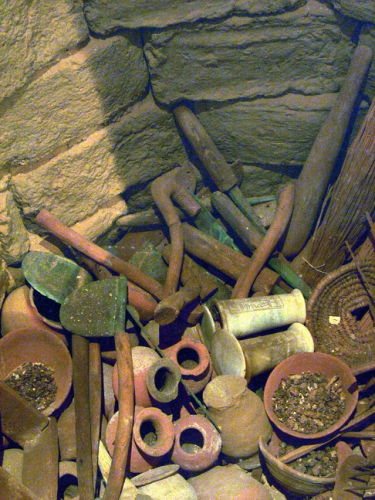
Reconstruction of a Foundation Deposit, New Kingdom, 18th Dynasty, joint reign of Hatshepsut and Thutmose III, ca. 1479–1458 B.C.
IMAGE LINKED: Metropolitan Museum of Art – Open Access PD licence
More examples of items found in one single excavation was from Hatshepsut’s tomb (KV20) in the Valley of the King’s – the alabaster jar bears the inscription of Maatkare (Hatshepsut’s coronation name), other items include models of a carpenter’s adze, a mason’s float, reed mats, a brick mould, a knot amulet, and several picks/tools.

left: from the Foundation Deposit for Hatshepsut’s Tomb, ca. 1479–1458 B.C. New Kingdom.
right: Model Mason’s Float from the Foundation Deposit for Hatshepsut’s Tomb, ca. 1479–1458 B.C. New Kingdom.
IMAGE LINKED: www.metmuseum.org OA Public Domain Licence
Similar ceremonies were performed across the globe, often involving offerings of grain, wine and oil placed under the foundation or cornerstone.
These items were symbolic of the need for consistent sustenance and fertility of the crops so that the people of the land would prosper.
Practices in more primitive times may well have included the sacrifice of an animal or human, the body/bodies to be laid within the foundations.
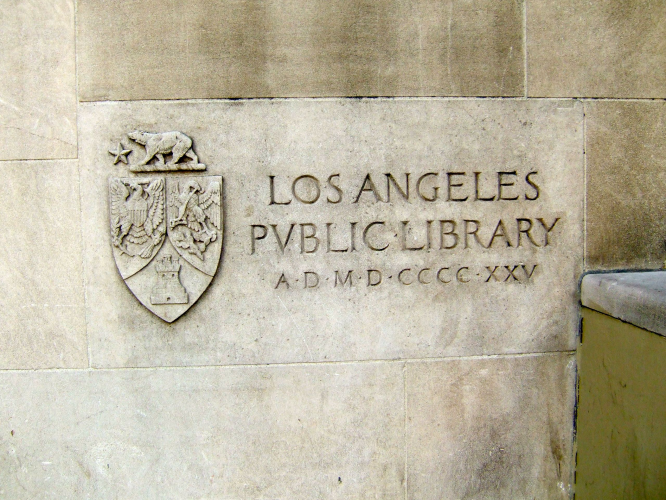
eremonial masonry stone of the Los Angeles Central Library building, laid in 1925. By BeenAroundAWhile
IMAGE LINKED: wikimedia Attribution 4.0 International (CC BY 4.0)
Over time, the laying of cornerstones evolved into more civic ceremonies, the actual foundation stone was transformed into a symbolic replica that was often incorporated into a prominent corner or wall of an important building.
An inscription would be added usually stating the date of construction, the name of the architect or notable persons who performed the ceremony.
In the past few centuries, the inclusion of a ‘time capsule’ is a definite nod to the foundation deposits found in antiquity, although the contents have been rather more varied and, in some cases, rather bizarre.
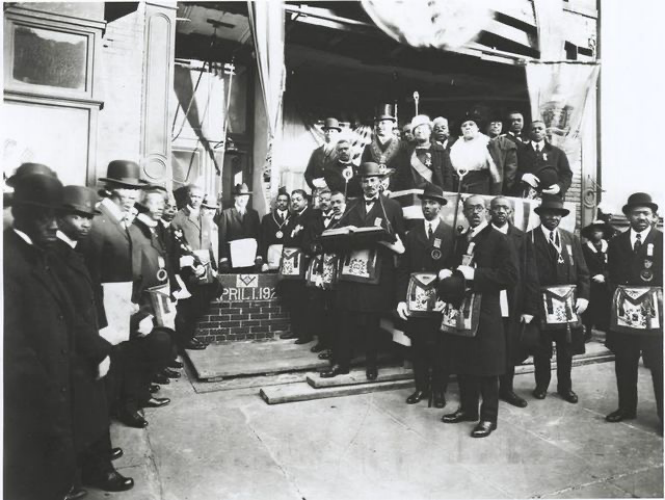
Schomburg among Masons and Odd Fellows at the cornerstone laying of the Ionic Temple, 165 or 167 Claremont Avenue, Brooklyn, N.Y., April 1, 1922.
IMAGE Credit: NYPL Digital Creative Commons CC0 1.0 Universal Public Domain Dedication
These Builders’ Rites or Foundation Ceremonies play an important part in both Operative and Speculative Freemasonry. In more recent times Masonic groups across the world have often been invited to take part in public cornerstone laying ceremonies.
One such notable occasion was during the erection of the famous ancient Egyptian obelisk known as Cleopatra’s Needle on London’s Embankment in 1878. Several of the men involved in the transportation and placement of the obelisk were prominent Freemasons and the original master stone mason who worked on the granite foundation was William Henry Gould (1822–1891).
A time capsule was placed within the front of the pedestal and contained:
…a set of 12 photographs of the best-looking English women of the day, a box of hairpins, a box of cigars, several tobacco pipes, a set of imperial weights, a baby’s bottle, some children’s toys, a shilling razor, a hydraulic jack and some samples of the cable used in the erection, a 3-foot (90-centimetre) bronze model of the monument, a complete set of contemporary British coins, a rupee, a portrait of Queen Victoria, a written history of the transport of the monument plans, on vellum, a translation of the inscriptions, copies of the Bible in several languages, a copy of John 3:16 in 215 languages, a copy of Whitaker’s Almanack, a Bradshaw Railway Guide, a map of London and copies of 10 daily newspapers.
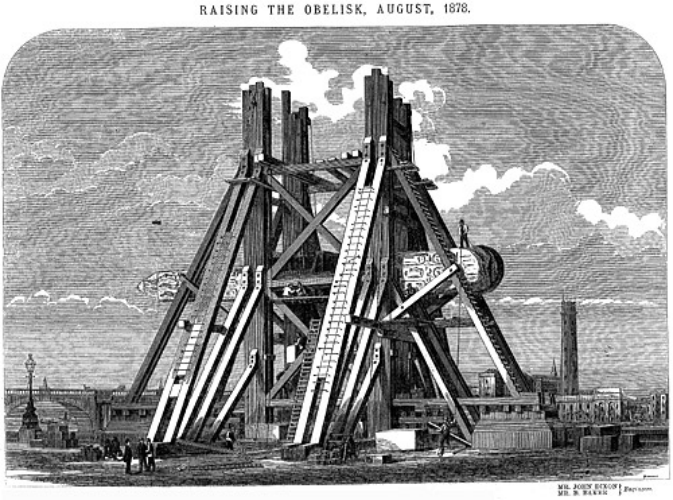
Raising the obelisk, August 1878
IMAGE LINKED: wikimedia Attribution 4.0 International (CC BY 4.0)
Another foundation stone ceremony that involved Freemasons was described by The Cork Examiner, 13 January 1865:
…The Deputy Provincial Grand Master of Munster, applying the golden square and level to the stone said; “My Lord Bishop, the stone has been proved and found to be ‘fair work and square work’ and fit to be laid as the foundation stone of this Holy Temple”.’
After this, Bishop Gregg spread cement over the stone with a trowel specially made for the occasion by John Hawkesworth, a silversmith, and a jeweller.
He then gave the stone three knocks with a mallet and declared the stone to be ‘duly and truly laid’.
The Deputy Provincial Grand Master of Munster poured offerings of corn, oil, and wine over the stone after Bishop Gregg had declared it to be ‘duly and truly laid’.
The Provincial Grand Chaplain of the Masonic Order in Munster then read out the following prayer: ‘May the Great Architect of the universe enable us as successfully to carry out and finish this work. May He protect the workmen from danger and accident, and long preserve the structure from decay; and may He grant us all our needed supply, the corn of nourishment, the wine of refreshment, and the oil of joy, Amen.
So mote it be.’ The choir and congregation then sang the Hundredth Psalm.
Here follows an explanation of the ‘Symbolism of the Corner-Stone’ by Albert G. Mackey, from Chapter 13 of his book The Symbolism of Freemasonry [1882]

XXIII
Symbolism of the Corner-stone
We come next, in a due order of precedence, to the consideration of the symbolism connected with an important ceremony in the ritual of the first degree of Masonry, which refers to the north-east corner of the lodge.
In this ceremony the candidate becomes the representative of a spiritual corner-stone.
And hence, to thoroughly comprehend the true meaning of the emblematic ceremony, it is essential that we should investigate the symbolism of the corner-stone.
The corner-stone, as the foundation on which the entire building is supposed to rest, is, of course, the most important stone in the whole edifice.
It is, at least, so considered by Operative Masons. It is laid with impressive ceremonies; the assistance of Speculative Masons is often, and always ought to be, invited, to give dignity to the occasion; and the event is viewed by the workmen as an important era in the construction of the edifice.
In the rich imagery of Orientalism, the corner-stone is frequently referred to as the appropriate symbol of a chief or prince who is the defence and bulwark of his people, and more particularly in Scripture, as denoting that promised Messiah who was to be the sure prop and support of all who should put their trust in his divine mission.
To the various properties that are necessary to constitute a true corner-stone, its firmness and durability, its perfect form, and its peculiar position as the connecting link between the walls, – we must attribute the important character that it has assumed in the language of symbolism.
Freemasonry, which alone, of all existing institutions, has preserved this ancient and universal language, could not, as it may well be supposed, have neglected to adopt the corner-stone among its most cherished and impressive symbols; and hence it has referred to it many of its most significant lessons of morality and truth.
I have already alluded to that peculiar mode of Masonic symbolism by which the Speculative Mason is supposed to be engaged in the construction of a spiritual temple, in imitation of, or, rather, in reference to, that material one which was erected by his operative predecessors at Jerusalem.
Let us again, for a few moments, direct our attention to this important fact, and revert to the connection which originally existed between the operative and speculative divisions of Freemasonry.
This is an essential introduction to any inquiry into the symbolism of the corner-stone.

Solomon dedicates the Temple. Henry Davenport Northrop’s ‘Treasures of the Bible’, 1894.
IMAGE LINKED: wikimedia Attribution 4.0 International (CC BY 4.0)
The difference between operative and Speculative Masonry is simply this;
– that while the former was engaged in the construction of a material temple, formed, it is true, of the most magnificent materials which the quarries of Palestine, the mountains of Lebanon, and the golden shores of Ophir could contribute, the latter occupies itself in the erection of a spiritual house,
– a house not made with hands,
– in which, for stones and cedar, and gold and precious stones, are substituted the virtues of the heart, the pure emotions of the soul, the warm affections gushing forth from the hidden fountains of the spirit, so that the very presence of Jehovah, our Father and our God, shall be enshrined within us as his Shekinah was in the holy of holies of the material temple at Jerusalem.
The Speculative Mason, then, if he rightly comprehends the scope and design of his profession, is occupied, from his very first admission into the order until the close of his labors and his life;
– and the true Mason’s labor ends only with his life,
– in the construction, the adornment, and the completion of this spiritual temple of his body.
He lays its foundation in a firm belief and an unshaken confidence in the wisdom, power, and goodness of God.
This is his first step. Unless his trust is in God, and in him only, he can advance no further than the threshold of initiation.
And then he prepares his materials with the gauge and gavel of Truth, raises the walls by the plumb-line of Rectitude, squares his work with the square of Virtue, connects the whole with the cement of Brotherly Love, and thus skilfully erects the living edifice of thoughts, and words, and deeds, in accordance with the designs laid down by the Master Architect of the universe in the great Book of Revelation.
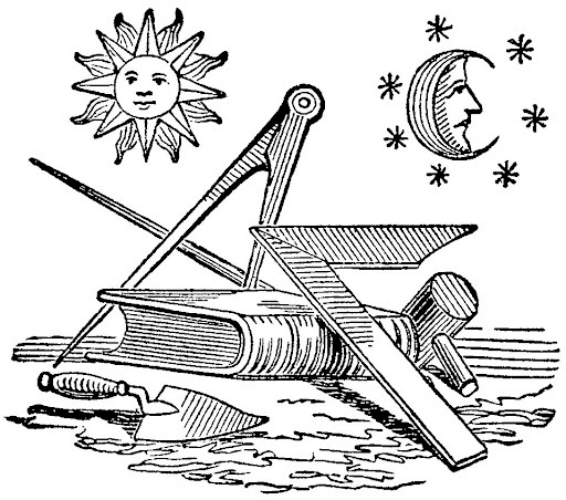
The aspirant for Masonic light – the Neophyte – on his first entrance within our sacred porch, prepares himself for this consecrated labor of erecting within his own bosom a fit dwelling-place for the Divine Spirit, and thus commences the noble work by becoming himself the corner-stone on which this spiritual edifice is to be erected.
Here, then, is the beginning of the symbolism of the corner-stone; and it is singularly curious to observe how every portion of the archetype has been made to perform its appropriate duty in thoroughly carrying out the emblematic allusions.
As, for example, this symbolic reference of the corner-stone of a material edifice to a Mason, when, at his first initiation, he commences the intellectual task of erecting a spiritual temple in his heart, is beautifully sustained in the allusions to all the various parts and qualities which are to be found in a “well-formed, true and trusty” corner-stone.
Its form and substance are both seized by the comprehensive grasp of the symbolic science.
Let us trace this symbolism in its minute details. And, first, as to the form of the corner-stone.
The corner-stone of an edifice must be perfectly square on its surfaces, lest, by a violation of this true geometric figure, the walls to be erected upon it should deviate from the required line of perpendicularity which can alone give strength and proportion to the building.
Perfectly square on its surfaces, it is, in its form and solid contents, a cube. Now, the square and the cube are both important and significant symbols.
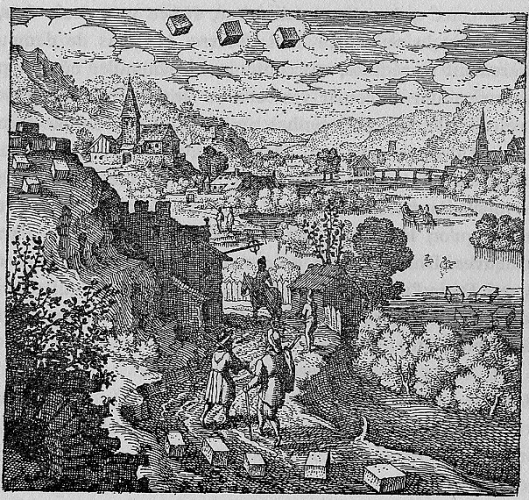
Alchemical emblem depicting the omnipresence of the philosophical matter. “The Stone that is Mercury, is cast upon the Earth, exalted on Mountains, resides in the Air, and is nourished in the Waters.” (Michael Maier’s Atalanta Fugiens. 1617.) The cubes represent prima materia.
IMAGE LINKED: wikimedia Attribution 4.0 International (CC BY 4.0)
The square is an emblem of morality, or the strict performance of every duty.
Among the Greeks, who were a highly poetical and imaginative people, the square was deemed a figure of perfection, and the ἀνὴρ τετράγωνος – “the square or cubical man”, as the words may be translated – was a term used to designate a man of unsullied integrity.
Hence one of their most eminent metaphysicians has said that “he who valiantly sustains the shocks of adverse fortune, demeaning himself uprightly, is truly good and of a square posture, without reproof; and he who would assume such a square posture should often subject himself to the perfectly square test of justice and integrity”.
The cube, in the language of symbolism, denotes truth. Among the pagan mythologists, Mercury, or Hermes, was always represented by a cubical stone, because he was the type of truth, and the same form was adopted by the Israelites in the construction of the tabernacle, which was to be the dwelling-place of divine truth.
And, then, as to its material: This, too, is an essential element of all symbolism.
Constructed of a material finer and more polished than that which constitutes the remainder of the edifice, often carved with appropriate devices, and fitted for its distinguished purpose by the utmost skill of the sculptor’s art, it becomes the symbol of that beauty of holiness with which the Hebrew Psalmist has said that we are to worship Jehovah.
The ceremony, then, of the north-east corner of the lodge, since it derives all its typical value from this symbolism of the corner-stone, was undoubtedly intended to portray, in this consecrated language, the necessity of integrity and stability of conduct, of truthfulness and uprightness of character, and of purity and holiness of life, which, just at that time and in that place, the candidate is most impressively charged to maintain.
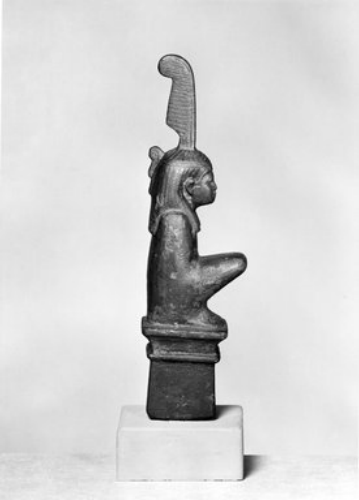
The Egyptian concept of Maat was a religious and moral upholding of truth, balance, uprightness, and justice – the goddess attributed to Maat is usually depicted seated upon a plinth, representing the foundation on which Egypt was built.
Statuette of the Goddess Maat Seated on a Shrine, ca. 664-332 B.C.E. Bronze, 3 7/8 x 1/2 x 1 1/16 in. (9.9 x 1.2 x 2.7 cm).
IMAGE LINKED: Brooklyn Museum, Charles Edwin Wilbour Fund, 37.561E. Creative Commons-BY (Photo: Brooklyn Museum
But there is also a symbolism about the position of the corner-stone, which is well worthy of attention.
It is familiar to everyone, – even to those who are without the pale of initiation, – that the custom of laying the corner-stones of public buildings has always been performed by the Masonic order with peculiar and impressive ceremonies, and that this stone is invariably deposited in the north-east corner of the foundation of the intended structure.
Now, the question naturally suggests itself, whence does this ancient and invariable usage derive its origin?
Why may not the stone be deposited in any other corner or portion of the edifice, as convenience or necessity may dictate?
The custom of placing the foundation-stone in the north-east corner must have been originally adopted for some good and sufficient reason; for we have a right to suppose that it was not an arbitrary selection.
Was it in reference to the ceremony which takes place in the lodge?
Or is that in reference to the position of the material stone?
No matter which has the precedence in point of time, the principle is the same.
The position of the stone in the north-east corner of the building is altogether symbolic, and the symbolism exclusively alludes to certain doctrines which are taught in the speculative science of Masonry.
The interpretation, I conceive, is briefly this: Every Speculative Mason is familiar with the fact that the east, as the source of material light, is a symbol of his own order, which professes to contain within its bosom the pure light of truth.
As, in the physical world, the morning of each day is ushered into existence by the reddening dawn of the eastern sky, whence the rising sun dispenses his illuminating and prolific rays to every portion of the visible horizon, warming the whole earth with his embrace of light, and giving new-born life and energy to flower and tree, and beast and man, who, at the magic touch, awake from the sleep of darkness, so in the moral world, when intellectual night was, in the earliest days, brooding over the world, it was from the ancient priesthood living in the east that those lessons of God, of nature, and of humanity first emanated, which, travelling westward, revealed to man his future destiny, and his dependence on a superior power.
Thus, every new and true doctrine, coming from these “wise men of the east,” was, as it were, a new day arising, and dissipating the clouds of intellectual darkness and error.
It was a universal opinion among the ancients that the first learning came from the east; and the often-quoted line of Bishop Berkeley, that – “Westward the course of empire takes its way”
– is but the modern utterance of an ancient thought, for it was always believed that the empire of truth and knowledge was advancing from the east to the west.
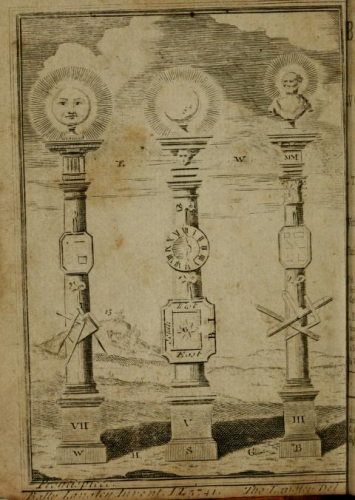
Frontispiece from The Builder’s Jewel, Batty and Thomas Langley, London, 1787.
Again: the north, as the point in the horizon which is most remote from the vivifying rays of the sun when at his meridian height, has, with equal metaphorical propriety, been called the place of darkness, and is, therefore, symbolic of the profane world, which has not yet been penetrated and illumined by the intellectual rays of Masonic light.
All history concurs in recording the fact that, in the early ages of the world, its northern portion was enveloped in the most profound moral and mental darkness.
It was from the remotest regions of Northern Europe that those barbarian hordes “came down like the wolf on the fold,” and devastated the fair plains of the south, bringing with them a dark curtain of ignorance, beneath whose heavy folds the nations of the world lay for centuries overwhelmed.
The extreme north has ever been, physically and intellectually, cold, and dark, and dreary.
Hence, in Masonry, the north has ever been esteemed the place of darkness; and, in obedience to this principle, no symbolic light is allowed to illumine the northern part of the lodge.
The east, then, is, in Masonry, the symbol of the order, and the north the symbol of the profane world.
Now, the spiritual corner-stone is deposited in the north-east corner of the lodge, because it is symbolic of the position of the neophyte, or candidate, who represents it in his relation to the order and to the world.
From the profane world he has just emerged. Some of its imperfections are still upon him; some of its darkness is still about him; he as yet belongs in part to the north.
But he is striving for light and truth; the pathway upon which he has entered is directed towards the east.
His allegiance, if I may use the word, is divided. He is not altogether a profane, nor altogether a Mason.
If he were wholly in the world, the north would be the place to find him – the north, which is the reign of darkness.
If he were wholly in the order, – a Master Mason, – the east would have received him – the east, which is the place of light.
But he is neither; he is an Apprentice, with some of the ignorance of the world cleaving to him, and some of the light of the order beaming upon him.
And hence this divided allegiance – this double character – this mingling of the departing darkness of the north with the approaching brightness of the east – is well expressed, in our symbolism, by the appropriate position of the spiritual corner-stone in the north-east corner of the lodge.
One surface of the stone faces the north, and the other surface faces the east.
It is neither wholly in the one part nor wholly in the other, and in so far it is a symbol of initiation not fully developed – that which is incomplete and imperfect, and is, therefore, fitly represented by the recipient of the first degree, at the very moment of his initiation.
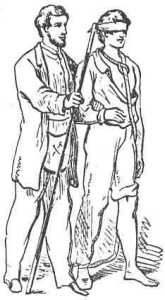
But the strength and durability of the corner-stone are also eminently suggestive of symbolic ideas.
To fulfil its design as the foundation and support of the massive building whose erection it precedes, it should be constructed of a material which may outlast all other parts of the edifice, so that when that “eternal ocean whose waves are years” shall have ingulfed all who were present at the construction of the building in the vast vortex of its ever-flowing current; and when generation after generation shall have passed away, and the crumbling stones of the ruined edifice shall begin to attest the power of time and the evanescent nature of all human undertakings, the corner-stone will still remain to tell, by its inscriptions, and its form, and its beauty, to every passer-by, that there once existed in that, perhaps then desolate, spot, a building consecrated to some noble or some sacred purpose by the zeal and liberality of men who now no longer live.
So, too, do this permanence and durability of the corner-stone, in contrast with the decay and ruin of the building in whose foundations it was placed, remind the Mason that when this earthly house of his tabernacle shall have passed away, he has within him a sure foundation of eternal life – a corner-stone of immortality – an emanation from that Divine Spirit which pervades all nature, and which, therefore, must survive the tomb, and rise, triumphant and eternal, above the decaying dust of death and the grave.
It is in this way that the student of Masonic symbolism is reminded by the corner-stone – by its form, its position, and its permanence – of significant doctrines of duty, and virtue, and religious truth, which it is the great object of Masonry to teach.
But I have said that the material corner-stone is deposited in its appropriate place with solemn rites and ceremonies, for which the order has established a peculiar ritual. These, too, have a beautiful and significant symbolism, the investigation of which will next attract our attention.
And here it may be observed, in passing, that the accompaniment of such an act of consecration to a particular purpose, with solemn rites and ceremonies, claims our respect, from the prestige that it has of all antiquity.
A learned writer on symbolism makes, on this subject, the following judicious remarks, which may be quoted as a sufficient defence of our Masonic ceremonies: –
It has been an opinion, entertained in all past ages, that by the performance of certain acts, things, places, and persons acquire a character which they would not have had without such performances.
The reason is plain: certain acts signify firmness of purpose, which, by consigning the object to the intended use, gives it, in the public opinion, an accordant character.
This is most especially true of things, places, and persons connected with religion and religious worship.
After the performance of certain acts or rites, they are held to be altogether different from what they were before; they acquire a sacred character, and in some instances a character absolutely divine. Such are the effects imagined to be produced by religious dedication.
The stone, therefore, thus properly constructed, is, when it is to be deposited by the constituted authorities of our order, carefully examined with the necessary implements of Operative Masonry;
– the square, the level, and the plumb,
– and declared to be “well-formed, true, and trusty”.
This is not a vain nor unmeaning ceremony.
It teaches the Mason that his virtues are to be tested by temptation and trial, by suffering and adversity, before they can be pronounced by the Master Builder of souls to be materials worthy of the spiritual building of eternal life, fitted “as living stones, for that house not made with hands, eternal in the heavens”.
But if he be faithful, and withstand these trials;
– if he shall come forth from these temptations and sufferings like pure gold from the refiner’s fire,
– then, indeed, shall he be deemed “well-formed, true, and trusty”, and worthy to offer “unto the Lord an offering in righteousness”.
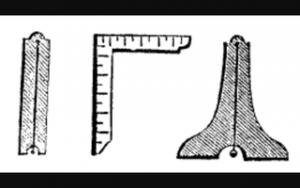
In the ceremony of depositing the corner-stone, the sacred elements of Masonic consecration are then produced, and the stone is solemnly set apart by pouring corn, wine, and oil upon its surface. Each of these elements has a beautiful significance in our symbolism.
Collectively, they allude to the Corn of Nourishment, the Wine of Refreshment, and the Oil of Joy, which are the promised rewards of a faithful and diligent performance of duty, and often specifically refer to the anticipated success of the undertaking whose incipiency they have consecrated.
They are, in fact, types and symbols of all those abundant gifts of Divine Providence for which we are daily called upon to make an offering of our thanks, and which are enumerated by King David, in his catalogue of blessings, as “wine that maketh glad the heart of man, and oil to make his face to shine, and bread which strengtheneth man’s heart”.

“Wherefore, my brethren,” says Harris, “do you carry corn, wine, and oil in your processions, but to remind you that in the pilgrimage of human life you are to impart a portion of your bread to feed the hungry, to send a cup of your wine to cheer the sorrowful, and to pour the healing oil of your consolation into the wounds which sickness hath made in the bodies, or affliction rent in the hearts, of your fellow-travellers?”
But, individually, each of these elements of consecration has also an appropriate significance, which is well worth investigation.
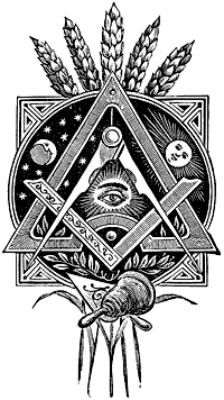
Corn, in the language of Scripture, is an emblem of the resurrection, and St. Paul, in that eloquent discourse which is so familiar to all, as a beautiful argument for the great Christian doctrine of a future life, adduces the seed of grain, which, being sown, first dieth, and then quickeneth, as the appropriate type of that corruptible which must put on incorruption, and of that mortal which must assume immortality.
But, in Masonry, the sprig of acacia, for reasons purely Masonic, has been always adopted as the symbol of immortality, and the ear of corn is appropriated as the symbol of plenty.
This is in accordance with the Hebrew derivation of the word, as well as with the usage of all ancient nations.
The word dagan, דנו which signifies corn, is derived from the verb dagah, דנה, to increase, to multiply, and in all the ancient religions the horn or vase, filled with fruits and with grain, was the recognized symbol of plenty.
Hence, as an element of consecration, corn is intended to remind us of those temporal blessings of life and health, and comfortable support, which we derive from the Giver of all good, and to merit which we should strive, with “clean hands and a pure heart,” to erect on the corner-stone of our initiation a spiritual temple, which shall be adorned with the “beauty of holiness”.
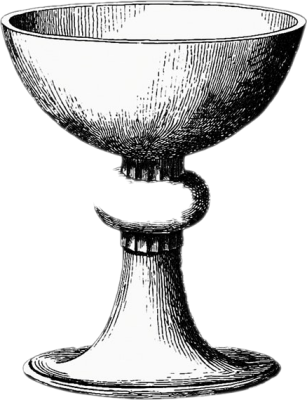
Wine is a symbol of that inward and abiding comfort with which the heart of the man who faithfully performs his part on the great stage of life is to be refreshed; and as, in the figurative language of the East, Jacob prophetically promises to Judah, as his reward, that he shall wash his garments in wine, and his clothes in the blood of the grape, it seems intended, morally, to remind us of those immortal refreshments which, when the labors of this earthly lodge are forever closed, we shall receive in the celestial lodge above, where the G.A.O.T.U. forever presides.
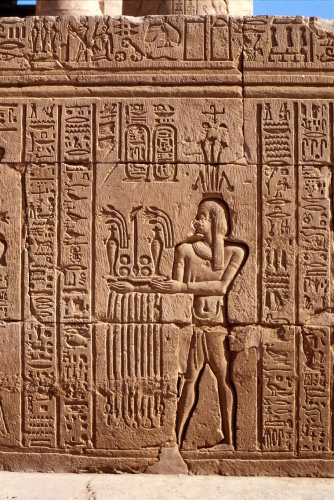
Temple offering of wine, oil, flowers, cakes and bread.
IMAGE Credit: Carole Reeves. Attribution 4.0 International (CC BY 4.0)
Oil is a symbol of prosperity, and happiness, and joy. The custom of anointing everything or person destined for a sacred purpose is of venerable antiquity.
The statues of the heathen deities, as well as the altars on which the sacrifices were offered to them, and the priests who presided over the sacred rites, were always anointed with perfumed ointment, as a consecration of them to the objects of religious worship.
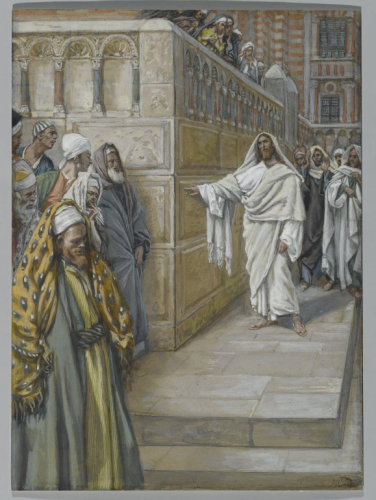
James Tissot (French, 1836-1902). The Corner Stone (Le pierre angulaire), 1886-1894.
IMAGE Credit: Brooklyn Museum
When Jacob set up the stone on which he had slept in his journey to Padan-aram, and where he was blessed with the vision of ascending and descending angels, he anointed it with oil, and thus consecrated it as an altar to God.
Such an injunction was, in ancient times, as it still continues to be in many modern countries and contemporary religions, a symbol of the setting apart of the thing or person so anointed and consecrated to a holy purpose.
Hence, then, we are reminded by this last impressive ceremony, that the cultivation of virtue, the practice of duty, the resistance of temptation, the submission to suffering, the devotion to truth, the maintenance of integrity, and all those other graces by which we strive to fit our bodies, as living stones, for the spiritual building of eternal life, must, after all, to make the object effectual and the labor successful, be consecrated by a holy obedience to God’s will and a firm reliance on God’s providence, which alone constitute the chief corner-stone and sure foundation, on which any man can build with the reasonable hope of a prosperous issue to his work.
It may be noticed, in concluding this topic, that the corner-stone seems to be peculiarly a Jewish symbol.
I can find no reference to it in any of the ancient pagan rites, and the EBEN PINAH, the corner-stone, which is so frequently mentioned in Scripture as the emblem of an important personage, and most usually, in the Old Testament, of the expected Messiah, appears, in its use in Masonry, to have had, unlike almost every other symbol of the order, an exclusively temple origin.
Additional text sources: – Wikipedia Commons

The Symbolism of Freemasonry
By: Albert G. Mackey
Of the various modes of communicating instruction to the uninformed, the Masonic student is particularly interested in two; namely, the instruction by legends and that by symbols.
It is to these two, almost exclusively, that he is indebted for all that he knows, and for all that he can know, of the philosophic system which is taught in the institution.
All its mysteries and its dogmas, which constitute its philosophy, are entrusted for communication to the neophyte, sometimes to one, sometimes to the other of these two methods of instruction, and sometimes to both of them combined.
The Freemason has no way of reaching any of the esoteric teachings of the Order except through the medium of a legend or a symbol. Read more….
Recent Articles: symbolism
 The Practice of Freemasonry - P1 Embark on a transformative journey with Freemasonry, where the exploration of your Center unlocks the Perfect Ashlar within. Through the practices of Brotherly Love, Relief, Truth, and Cardinal Virtues, discover a path of enlightenment and self-improvement. Embrace the universal creed that binds us in the pursuit of our true essence. |
 Discover the fascinating history and significance of the Warrant of Constitution within Freemasonry. Unveil the evolution of this crucial authorization, its role in legitimizing Lodges, and its lasting impact on the global brotherhood of Freemasons. Explore the intricate link it provides between tradition and modern practice. |
 Freemasonry: Unravelling the Complexity of an Influential Organization Mysterious and captivating, Freemasonry has piqued the interest of seekers and skeptics alike. With its intricate blend of politics, esotericism, science, and religion, this enigmatic organization has left an indelible mark on society. Prepare to delve into the secrets of Freemasonry and unlock its hidden depths. |
 Unlocking the Mysteries of Freemasonry: In the hallowed halls of Freemasonry, a powerful symbol lies at the heart of ancient rituals and teachings—the Volume of the Sacred Law. This sacred book not only guides the spiritual and moral journey of Freemasons but also serves as a beacon of universal wisdom and enlightenment. |
 The Ancient Liberal Arts in Freemasonry Embark on a journey of self-improvement and wisdom with Freemasonry's guiding principles. Ascend the winding stairs of moral cultivation, analytical reasoning, and philosophical understanding. Embrace arithmetic's mystical properties and geometry's universal truths. Let the harmony of the universe inspire unity and growth. Discover the profound, hidden knowledge in Freemasonry's path to enlightenment. |
 Initiation rituals around the world are filled with fascinating elements and different images. One of them is that of darkness. When societies speak of darkness, they often mean a lack of knowledge, a lack of choice, or a symbol of evil. During initiation rituals, darkness is used to represent the initiate's lack of knowledge about the world, society, and initiation in general. It can also represent the initiate's inability to make a choice or endure a situation. Whether you have participated in an initiation rite or not, the meaning of darkness remains an intriguing concept worth exploring. Initiation rituals around the world are filled with fascinating elements and different images. One of them is that of darkness. When societies speak of darkness, they often mean a lack of knowledge, a lack of choice, or a symbol of evil. During initiation rituals, darkness is used to represent the initiate's lack of knowledge about the world, society, and initiation in general. It can also represent the initiate's inability to make a choice or endure a situation. Whether you have participated in an initiation rite or not, the meaning of darkness remains an intriguing concept worth exploring. |
 Masonic Deacon rods potentially trace their origins to Greek antiquity, symbolically linked to Hermes' caduceus. As Hermes bridged gods and mortals with messages, so do Masonic Deacons within the lodge, reinforcing their roles through ancient emblems. This connection underscores a profound narrative, weaving the fabric of Masonic rites with the threads of mythological heritage, suggesting the rods are not mere tools but bearers of deeper, sacred meanings that resonate with the guardianship and communicative essence of their divine counterpart, Hermes, reflecting a timeless lineage from myth to Masonic tradition. |
 The biblical pillars erected by Solomon at the Temple's porch, hold a profound place in history. These brass behemoths are not mere decorations; they are symbols of strength, establishment, and divine guidance. Explore their fascinating construction, dimensions, and the deep meanings they carry in both biblical and Masonic contexts. |
 Unlocking the Mind's Potential: Dive deep into ground breaking research revealing how simple daily habits can supercharge cognitive abilities. Discover the untapped power within and redefine your limits. Join us on this enlightening journey and transform your world! |
 Dive deep into the symbolic importance of the trowel in Masonry, representing unity and brotherly love. From its historical roots in operative masonry to its significance in speculative masonry, this article explores the trowel's multifaceted role. Discover its connection to the sword, the story of Nehemiah, and the Society of the Trowel in Renaissance Florence. Unravel the layers of meaning behind this enduring Masonic symbol. |
 Symbolism of The Builder's Jewel Batty Langley's "The Builder’s Jewel" (1741) is a visual masterpiece of Masonic symbolism, showcasing Langley's deep understanding of Freemasonry. The frontispiece highlights key symbols like the three pillars and the legend of Hiram Abiff, emphasizing Langley's dedication to Masonic traditions and teachings. |
 Unveil the mystique of the colour blue in Masonic symbolism. A hue evoking universal friendship and benevolence, its roots span ancient cultures, infusing Freemasonry's core values. This article explores blue's profound significance, guiding Freemasons towards wisdom and spiritual enlightenment. Discover the fascinating journey of this universal symbol. |
 Discover the intriguing world of the plumb in Masonic symbolism with our in-depth analysis. Uncover its rich history, moral teachings, and significance in Freemasonry, guiding members on their path to truth, integrity, and justice. Immerse yourself in the captivating power of this symbol that shapes lives within the brotherhood. |
 Unlock the mysteries of Freemasonry with 'The Key,' a profound Masonic symbol. This seemingly simple instrument holds a deeper meaning, teaching virtues of silence and integrity. Explore its ancient roots, from Sophocles to the mysteries of Isis, and discover how it symbolizes the opening of the heart for judgment. |
 Unlock the secrets of the Freemasonry with The Blazing Star - a symbol that holds immense significance in their rituals and practices. Delve into its history, meaning and role in the different degrees of Freemasonry with expert insights from the Encyclopedia of Freemasonry by Albert Mackey. Discover the mystique of The Blazing Star today! |
 There is no symbol more significant in its meaning, more versatile in its application, or more pervasive throughout the entire Freemasonry system than the triangle. Therefore, an examination of it cannot fail to be interesting to a Masonic student. Extract from Encyclopedia of Freemasonry by Albert Mackey |
 The Hiramic Legend and the Myth of Osiris Hiram Abiff, the chief architect of Solomon’s Temple, is a figure of great importance to Craft Freemasonry, as its legend serves as the foundation of the Third Degree or that of a Master Mason. He is the central figure of an allegory that has the role of teaching the Initiate valuable alchemical lessons. Although his legend is anchored in biblical times, it may have much older roots. |
 This rite of investiture, or the placing upon the aspirant some garment, as an indication of his appropriate preparation for the ceremonies in which he was about to engage, prevailed in all the ancient initiations. Extract from The Symbolism of Freemasonry by Albert G. Mackey |
 The All-Seeing Eye of God, also known as the Eye of Providence, is a representation of the divine providence in which the eye of God watches over humanity. It frequently portrays an eye that is enclosed in a triangle and surrounded by rays of light or splendour. |
 What's in a Word, Sign or Token? Why do Freemasons use passwords, signs, and tokens? As Freemasons we know and understand the passwords, signs and tokens (including grips), which are all used a mode of recognition between members of the fraternity. |
 A Temple of Living Stones: Examining the Concept of a Chain of Union What are the origins of the Chain of Union? And how did they come about ? The answers may surprise some members as W Brother Andrew Hammer investigates, author of Observing the Craft: The Pursuit of Excellence in Masonic Labour and Observance. |
 One of the best loved stories for the festive season is ‘A Christmas Carol’. A traditional ghost story for retelling around the fire on a cold Christmas Eve, it is a timeless classic beloved by those from all walks of life. Philippa explores the masonic allegory connections… |
 The Trowel - Working Tool of the Master Mason The Trowel is the symbol of that which has power to bind men together – the cement is brotherhood and fellowship. |
 Two Perpendicular Parallel Lines The point within a circle embordered by two perpendicular parallel lines, with the Holy Bible resting on the circle, is one of the most recognizable symbols in Freemasonry. It is also one which always raises a question. How can two lines be both perpendicular and parallel? |
 "The first great duty, not only of every lodge, but of every Mason, is to see that the landmarks of the Order shall never be impaired." — Albert Mackey (1856) |
 It is common knowledge that the ancient wages of a Fellowcraft Mason consisted of corn, wine, and oil. |
 “Do not come any closer,” God said. “Take off your sandals, for the place where you are standing is holy ground.” Exodus 3:5 |
 The Secret Language of the Stone Masons We know of Masons' Marks but lesser known are the 'argots' used by the artisans - in part 2 of a series on the social history of the Operative Masons we learn how the use of secret languages added to the mystery of the Guilds. |
 The phrase appears in the Regius Poem. It is customary in contemporary English to end prayers with a hearty “Amen,” a word meaning “So be it.” It is a Latin word derived from the Hebrew word - Short Talk Bulletin - Vol. V June, 1927, No.6 |
 Egypt's 'Place of Truth' - The First Operative Stone Masons' Guild? Was ancient Egypt's 'village of the artisans' the first operative stone masons' guild? And was their use of 'identity marks' a forerunner of the Mason's Marks of the cathedral builders of the Middle Ages? Read on for some possible answers… |
 The Pieces of Architecture and the Origin of Masonic Study Discover the journey of the Apprentice – from Operative to Speculative. This journey has been carried out since the times of operative Freemasonry but today the initiate works in the construction of his inner temple. |
 The Builders' Rites - laying the foundations operatively and speculatively The cornerstone (also ‘foundation’ or ‘setting’ stone) is the first stone to be set in the construction of the foundations of a building; every other stone is set in reference to this. |
 Applying the working tools to achieve our peculiar system of morality. |
 We take an in-depth look at the 47th Proposition of the 1st Book of Euclid as part of the jewel of the Past Master. |
 The Cable Tow: Its Origins, Symbolism, & Significance for Freemasons - Unbinding the significance of the cable tow. |
 We examine at one of the most impressive moments of the initiatory ceremony, a certain rite known as Circumambulation, and ask what is its meaning and purpose ? |
 So, what is the Level? And why do we use it in Freemasonry? |
 What is the mysterious pigpen or Masonic cipher that has been used for centuries to hide secrets and rituals? |
 The Story of the Royal Arch - The Mark Degree Extracted from William Harvey's 'The Story of the Royal Arch' - Part 1 describes the Mark Degree, including the Working Tools. |
 Ashlars - Rough, Smooth - Story of a Stone How we can apply the rough and smooth Ashlars with-in a masonic context |
 A detailed look at the Chamber of Reflection: A Revitalized and Misunderstood Masonic Practice. |
 Exploring the origin and symbolism of Faith, Hope and Charity |
 The Noachite Legend and the Craft What is it to be a true Noachidae, and what is the Noachite Legend and the Craft ? |
 In Masonic rituals, Jacob’s ladder is understood as a stairway, a passage from this world to the Heavens. |
 What is the meaning of the Acacia and where did it originate ? |
 What is the connection with the Feasts of St John and Freemasonry |
 The Forget-Me-Not and the Poppy - two symbols to remind us to 'never forget' those who died during the two World Wars. |
 Biblical history surrounding the two pillars that stood at the entrance to King Solomon's Temple |
 Is there a direct link between Judaism and Freemasonry? |
 The symbolism of the beehive in Masonry and its association with omphalos stones and the sacred feminine. |
 The Wages of an Entered Apprentice |
 An explanation of the North East corner charge which explores beyond one meaning Charity - |
 A brief look at the origins of the two headed eagle, probably the most ornamental and most ostentatious feature of the Supreme Council 33rd Degree Ancient and Accepted (Scottish ) Rite |
 A Muslim is reminded of his universal duties just as a Freemason. A Masonic Interpretation of the Quran's First Two Chapters |
 The three Latin words -{Listen, Observe, Be Silent}. A good moto for the wise freemason |
masonic knowledge
to be a better citizen of the world
share the square with two brothers

click image to open email app on mobile device



